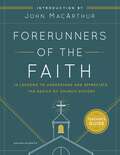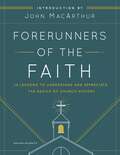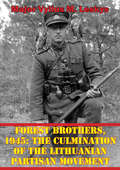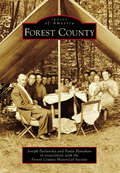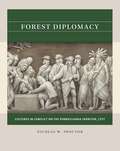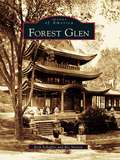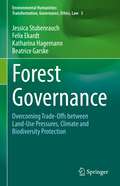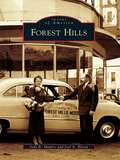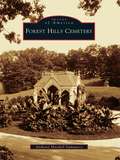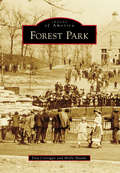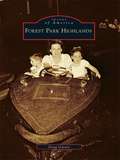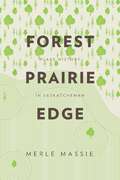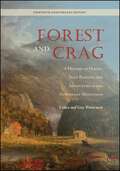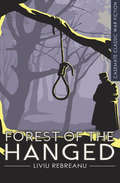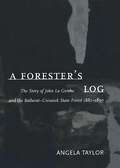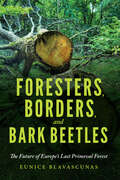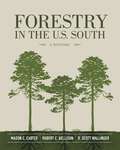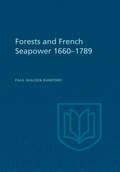- Table View
- List View
Forensic ugly: Volume 3 (Volume 3 #3)
by Wang FeiLiangLiangThe female medical examiner of the 21st century had provoked a handsome man as soon as she teleported.Not only did he jump into a murder mystery, but he was also ugly enough to shock the world and make the gods cry.His birth father didn't like it, his sisters were hypocritical, and the crown prince ruined the marriage!What could he do? Of course it was to go back to the old ways and live on!This infuriated him to death. He tore apart the white lotuses with his hands, kicked out the dregs with his feet, broke through all the mysteries, and from then on, ascended to the peak of his life.Hey, what's going on with that devilish man?He despised her figure! They despised her for being ugly!But it would always come!She angrily roared at him, "Scram! I don't need a man in my world!"
Forensic ugly: Volume 4 (Volume 4 #4)
by Wang FeiLiangLiangThe female medical examiner of the 21st century had provoked a handsome man as soon as she teleported.Not only did he jump into a murder mystery, but he was also ugly enough to shock the world and make the gods cry.His birth father didn't like it, his sisters were hypocritical, and the crown prince ruined the marriage!What could he do? Of course it was to go back to the old ways and live on!This infuriated him to death. He tore apart the white lotuses with his hands, kicked out the dregs with his feet, broke through all the mysteries, and from then on, ascended to the peak of his life.Hey, what's going on with that devilish man?He despised her figure! They despised her for being ugly!But it would always come!She angrily roared at him, "Scram! I don't need a man in my world!"
Forensic ugly: Volume 5 (Volume 5 #5)
by Wang FeiLiangLiangThe female medical examiner of the 21st century had provoked a handsome man as soon as she teleported.Not only did he jump into a murder mystery, but he was also ugly enough to shock the world and make the gods cry.His birth father didn't like it, his sisters were hypocritical, and the crown prince ruined the marriage!What could he do? Of course it was to go back to the old ways and live on!This infuriated him to death. He tore apart the white lotuses with his hands, kicked out the dregs with his feet, broke through all the mysteries, and from then on, ascended to the peak of his life.Hey, what's going on with that devilish man?He despised her figure! They despised her for being ugly!But it would always come!She angrily roared at him, "Scram! I don't need a man in my world!"
Forensische Psychologie in Deutschland: Zeugenschaft des Verbrechens, 1880-1939
by Heather WolfframDieses Buch untersucht die Entstehung und frühe Entwicklung der forensischen Psychologie in Deutschland vom späten neunzehnten Jahrhundert bis zum Ausbruch des Zweiten Weltkriegs und beleuchtet die interdisziplinären Anfänge und die umstrittene Entwicklung des Fachs. Ursprünglich als Psychologie aller an Strafverfahren Beteiligten gedacht, versprach diese neue Disziplin, sich von der ausschließlichen Konzentration auf den Kriminellen zu lösen und eine ganzheitliche Sichtweise der Auswirkungen menschlicher Fehlbarkeit auf die Strafjustiz zu bieten. Wie in diesem Buch dargelegt wird, war die forensische Psychologie in der Zwischenkriegszeit jedoch weitgehend zu einer Psychologie des Zeugen geworden; ihr Fokus wurde durch die Anforderungen des Gerichtssaals eingeengt. Anhand detaillierter Studien des Berchtold-Prozesses von 1896 und des Frenzel-Prozesses von 1930 geht das Buch der Frage nach, ob die Spannungen zwischen Psychiatrie, Psychologie, Gerichtsmedizin, Pädagogik und Recht in Bezug auf psychologisches Fachwissen in der Gerichtspraxis präsent waren, und untersucht, warum sich bis 1939 noch kein klarer Sieger im "Kampf um die forensische Psychologie" abzeichnete.
Forerunners of the Faith Teacher's Guide: 13 Lessons to Understand and Appreciate the Basics of Church History
by Nathan BusenitzEnter God&’s Story of Faithfulness to His PeopleThe Christian faith extends beyond our personal experiences, our individual churches, and far beyond our present age. This, for the Christian, is great news. When we become acquainted with the legacy of our Christian heritage, we connect our stories to those of the faithful believers who have come before us. This connection is precisely what Nathan Busenitz, Dean of Faculty and professor of church history at The Master's Seminary, seeks to provide. Based on the bestselling Fundamentals of the Faith, Forerunners of the Faith outlines the biblical orthodoxy that characterizes the true church. Busenitz succinctly identifies thirteen key lessons that capture the trials and triumphs of the historical Church, providing insights for how the ancient Christians responded to the problems of their day to become the pillars of faith we now consider them to be. Learn how your faith stands on the shoulders of giants like Athanasius, Augustine, and Wycliffe. As more than a didactic resource, Forerunners of the Faith serves as spiritual encouragement as we remember the legacy of God&’s faithfulness to his people.
Forerunners of the Faith Teacher's Guide: 13 Lessons to Understand and Appreciate the Basics of Church History
by Nathan BusenitzEnter God&’s Story of Faithfulness to His PeopleThe Christian faith extends beyond our personal experiences, our individual churches, and far beyond our present age. This, for the Christian, is great news. When we become acquainted with the legacy of our Christian heritage, we connect our stories to those of the faithful believers who have come before us. This connection is precisely what Nathan Busenitz, Dean of Faculty and professor of church history at The Master's Seminary, seeks to provide. Based on the bestselling Fundamentals of the Faith, Forerunners of the Faith outlines the biblical orthodoxy that characterizes the true church. Busenitz succinctly identifies thirteen key lessons that capture the trials and triumphs of the historical Church, providing insights for how the ancient Christians responded to the problems of their day to become the pillars of faith we now consider them to be. Learn how your faith stands on the shoulders of giants like Athanasius, Augustine, and Wycliffe. As more than a didactic resource, Forerunners of the Faith serves as spiritual encouragement as we remember the legacy of God&’s faithfulness to his people.
Forerunners of the Faith: 13 Lessons to Understand and Appreciate the Basics of Church History
by Nathan BusenitzEnter God&’s Story of Faithfulness to His PeopleThe Christian faith extends beyond our personal experiences, our individual churches, and far beyond our present age. This, for the Christian, is great news. When we become acquainted with the legacy of our Christian heritage, we connect our stories to those of the faithful believers who have come before us. This connection is precisely what Nathan Busenitz, Dean of Faculty and professor of church history at The Master's Seminary, seeks to provide. Based on the bestselling Fundamentals of the Faith, Forerunners of the Faith outlines the biblical orthodoxy that characterizes the true church. Busenitz then succinctly identifies thirteen key lessons that capture the trials and triumphs of the historical Church, providing insights for how the ancient Christians responded to the problems of their day to become the pillars of faith we now consider them to be. Learn how your faith stands on the shoulders of giants like Athanasius, Augustine, and Wycliffe. As more than a didactic resource, Forerunners of the Faith serves as spiritual encouragement as we remember the legacy of God&’s faithfulness to his people.Using this teaching guide, become empowered and equipped to lead your group through Forerunners of the Faith. Find answers to every lesson and insightful teaching notes.
Forerunners of the Faith: 13 Lessons to Understand and Appreciate the Basics of Church History
by Nathan BusenitzEnter God&’s Story of Faithfulness to His PeopleThe Christian faith extends beyond our personal experiences, our individual churches, and far beyond our present age. This, for the Christian, is great news. When we become acquainted with the legacy of our Christian heritage, we connect our stories to those of the faithful believers who have come before us. This connection is precisely what Nathan Busenitz, Dean of Faculty and professor of church history at The Master's Seminary, seeks to provide. Based on the bestselling Fundamentals of the Faith, Forerunners of the Faith outlines the biblical orthodoxy that characterizes the true church. Busenitz then succinctly identifies thirteen key lessons that capture the trials and triumphs of the historical Church, providing insights for how the ancient Christians responded to the problems of their day to become the pillars of faith we now consider them to be. Learn how your faith stands on the shoulders of giants like Athanasius, Augustine, and Wycliffe. As more than a didactic resource, Forerunners of the Faith serves as spiritual encouragement as we remember the legacy of God&’s faithfulness to his people.Using this teaching guide, become empowered and equipped to lead your group through Forerunners of the Faith. Find answers to every lesson and insightful teaching notes.
Forest Brothers, 1945: The Culmination Of The Lithuanian Partisan Movement
by Major Vylius M. LeskysAlthough the resistance effort maintained its strength ideologically, the Lithuanian partisan movement never recovered from the culminating point in 1945 because of a shortfall in resources, a lack of external support, and the inability of resistance leadership to adapt rapidly enough against a comprehensive Soviet assimilation campaign.While many authors argue that the high point in the Lithuanian partisan war occurred between 1946 and 1947, the totality of evidence points towards a culmination in 1945 from which the effort never recovered. This culminating point may be attributed to a miscalculation of partisan resources on the part of their leadership as well as a lack of external support. The main reason for achieving culmination, however, rested in the inability of partisans to fight a conventional war against a massive, combined arms Soviet force. Mass deportations between three separate occupations and a wave of 60,000 escapees created a vacuum of political, military and moral leadership. Compounded with the realization that there would be no external support from the democratic West, the will of the Lithuanians was bent by the Soviet campaign. Ultimately, the numbers of partisans killed, captured or given amnesty by Soviet forces reflect an apex in military capability in 1945 that drastically diminished thereafter.The pinnacle of partisan effort in 1945 clearly represents a culminating point that forced the Lithuanian resistance movement to shift their operations drastically. Ultimately, based on the totality of evidence, the 1945 culminating point splits the resistance into two stages: 1) 1944-1945-conventional war operations, a period of traditional offensive warfare by an organized partisan movement; and 2) 1946-1953-irregular warfare operations, a period of unremitting decline by a significantly diminished resistance, relegated to a more defensive posture and small scale offensive operations.
Forest County (Images of America)
by Joseph Pavlansky Paula Hanahan The Forest County Historical SocietyLocated within the western lands of Pennsylvania’s vast wilderness and rolling mountains, Forest County is known for its natural beauty and industrial history. With the Allegheny National Forest dominating the locale, Forest County is the third least populated county in Pennsylvania. Being recognized as an excellent place for outdoor adventures, the county is also known for its simplicity and for not having one traffic light within its boundaries. Over time, many have come to Forest County seeking opportunity and prosperity. When the surrounding counties were experiencing an oil boom, Forest County was exploring the lumber industry and dominating the business. To the hunters and fisherman that settled in Forest County, the wilderness was a utopia ripe with panther, deer, bear, wolves, bass, salmon, trout, and pike. The area is still revered for its vast wilds, which lend themselves to various recreational activities throughout the year.
Forest Diplomacy: Cultures In Conflict On The Pennsylvania Frontier 1757 (Reacting To The Past(tm) Ser.)
by Nicolas W. ProctorForest Diplomacy draws students into the colonial frontier, where Pennsylvania settlers and the Delaware Indians, or Lenâpé, are engaged in a vicious and destructive war. Using sources—including previous treaties, firsthand accounts of the war, Quaker epistles advocating pacifism, and various Iroquois and Lenâpé cultural texts—students engage in a treaty council to bring peace back to the frontier.
Forest Glen (Images of America)
by Rich Schaffer Ric NelsonForest Glen, Maryland, a sleepy suburb of Washington, D.C., has weathered the arrival of the railroad, construction of a summer resort, development of a fashionable girl's finishing school, and the establishment of a U.S. Army base. Throughout these times there has always been a close-knit community of homes and people that were often overshadowed by the many diverse events and changes that prevailed here. The focal point of the community--one of only a few extant eclectic architectural follies in the United States and consisting of many international styles--is listed on the National Register of Historic Places as the National Park Seminary Historic District.
Forest Governance: Overcoming Trade-Offs between Land-Use Pressures, Climate and Biodiversity Protection (Volume 3) (Environmental Humanities: Transformation, Governance, Ethics, Law)
by Katharina Hagemann Felix Ekardt Jessica Stubenrauch Beatrice GarskeThis book analyses and develops overarching concepts for forest policy and forest governance and includes a detailed investigation into the historical discussion on forests. It examines opportunities and limits for negative emissions in a sector that – like peatlands – appears significantly less ambivalent compared to highly technical large-scale forms of climate geoengineering. The analysis shows that the binding climate and biodiversity targets under international law are much more ambitious than most people assume. Measured against that, the volume critically reviews the potentials of afforestation and reforestation for climate mitigation, which is often presented as the new saviour to fulfil the commitments of the Paris Agreement and to reach climate neutrality in the future. It becomes clear that ultimately only biodiverse and thus resilient forests can function as a carbon sink in the long term. The volume shows that the existing European and international forest governance approaches fail to comply with these targets and insights. Furthermore, the book develops a bundle of policy measures. Quantity governance systems for livestock farming, fossil fuels and similar drivers of deforestations represent the most important approach. They are most effective when not directly targeting forests due to their heterogeneity but central damaging factors. With regard to the dominant regulatory and subsidy-based governance for forests we show that it remains necessary to supplement these quantity governance systems with certain easily graspable and thus controllable regulatory and subsidy regulations such as a regulatory protection of old-growth forests with almost no exceptions; extension of the livestock-to-land-ratio established in organic farming to all farming; far-reaching restriction of bioenergy use to certain residues flanked by import bans; and a national and international complete conversion of all agricultural and forest subsidies to “public money for public services” to promote nature conservation and afforestation in addition to the quantity control systems.
Forest Hill, Louisiana: A Bloom Town History (Brief History)
by Cheré Dastugue CoenForest Hill boasts one of the largest nursery industries in the country, despite its tiny population. In the early days, the community was a summer retreat for plantation owners. The lumber industry rolled into town with the railroad, which eased the transportation of virgin timber. By 1901, the nurseries had emerged after Samuel Stokes began selling a variety of plants from his woods. Today, more than two hundred nurseries are in operation, many by the families who founded them. Author Chere Dastugue Coen reveals the deep roots of this horticultural hub.
Forest Hills (Images of America)
by Joel A. Bloom Jody B. ShapiroAptly named because of its hilly terrain and abundance of trees, the area now known as Forest Hills was a dusty coal mining community in the late 1800s. Centered between two major roads, the Lincoln Highway (Ardmore Boulevard/U.S. Route 30) and the Greensburg Pike, Forest Hills was incorporated in 1919 in order to gain better representation for tax money. Technology put the town on the map with the first commercial licensed radio station broadcast in 1920 and the Westinghouse Atom Smasher, built in 1937. As the borough grew with new houses, schools, and parks, so did traditions such as the Fourth of July celebration at Forest Hills Park and the Bryn Mawr Corn Roast. Many who live in the community are third or fourth generation residents. Using vintage photographs, Forest Hills presents the untold story of this tight-knit community.
Forest Hills Cemetery
by Anthony Mitchell SammarcoLaid out in 1848 as a rural garden cemetery by Henry A. S. Dearborn, Forest Hills Cemetery celebrates its 160th anniversary in 2008 as Boston's premier arboretum cemetery. Since the mid-19th century, its 250 magnificent acres have been the resting place of people of all walks of life, ethnicities, religions, and races. Among these are poets Anne Sexton and E. E. Cummings, playwright Eugene O'Neill, and abolitionist William Lloyd Garrison. Forest Hills's landscape is a museum of sculpture, art, and monuments that chronicles the Victorian age to the present. The first crematorium in New England was here, and prominent Bostonian suffragette Lucy Stone was the first person to be cremated at Forest Hills in 1893. An active cemetery and an all-embracing place, Forest Hills offers a bucolic and picturesque setting for the "gathering of generations" and is listed on the National Register of Historic Places.
Forest Park (Images of America)
by Don Corrigan Holly ShanksAt 1,293 acres, Forest Park exceeds the size of New York’s Central Park by nearly 500 acres, and within are lakes, hills, wetlands, woodlands, and bountiful recreational opportunities. Within a few decades of its 1876 opening, Forest Park became the host for the 1904 St. Louis World’s Fair, as well as the 1904 Summer Olympics. Known as the “Heart of St. Louis,” the park features amazing attractions, such as the Saint Louis Zoo, the Saint Louis Art Museum, the Missouri History Museum, The Muny, and the Saint Louis Science Center. Millions of Americans have come to Forest Park for world-class festivities and for celebrations of heroes, from Lewis and Clark to explorers of outer space. Today, the park continues to host remarkable events, including Fair St. Louis, Earth Day, Shakespeare in the Park, and LouFest.
Forest Park Highlands
by Doug GarnerForest Park Highlands was once St. Louis's largest and best-known amusement park. In its earliest years, the Highlands boasted a fine theater and one of the largest public swimming pools in the United States. After the 1904 world's fair closed, several attractions found a new home at the Highlands; the large pagoda--a re-creation of the temple of Nekko, Japan--served as the park's bandstand for several years. Roller coasters are the lifeline of every good amusement park, and the Highlands always had two. The end came for the Highlands in a spectacular fire that decimated almost the entire park on July 19, 1963. Only the Comet roller coaster, the Ferris wheel, the Dodgems, the carousel, and the Aero Jets survived. Forest Park Highlands covers other historic amusement parks in St. Louis as well, starting with the earliest, West End Heights, and ending with Holiday Hill, the last remaining park.
Forest Prairie Edge: Place History in Saskatchewan
by Merle MassieSaskatchewan is the anchor and epitome of the ‘prairie’ provinces, even though half of the province is covered by boreal forest. The Canadian penchant for dividing this vast country into easily-understood ‘regions’ has reduced the Saskatchewan identity to its southern prairie denominator and has distorted cultural and historical interpretations to favor the prairie south. Forest Prairie Edge is a deep-time investigation of the edge land, or ecotone, between the open prairies and boreal forest region of Saskatchewan. Ecotones are transitions from one landscape to another, where social, economic, and cultural practices of different landscapes are blended. Using place history and edge theory, Massie considers the role and importance of the edge ecotone in building a diverse social and economic past that contradicts traditional “prairie” narratives around settlement, economic development, and culture. She offers a refreshing new perspective that overturns long-held assumptions of the prairies and the Canadian west.
Forest and Crag: A History of Hiking, Trail Blazing, and Adventure in the Northeast Mountains, Thirtieth Anniversary Edition (Excelsior Editions)
by Laura Waterman Guy WatermanThirty years after its initial publication, this beloved classic is back in print. Superbly researched and written, Forest and Crag is the definitive history of our love affair with the mountains of the Northeastern United States, from the Catskills and the Adirondacks of New York to the Green Mountains of Vermont, the White Mountains of New Hampshire, and the mountains of Maine. It's all here in one comprehensive volume: the struggles of early pioneers in America's first frontier wilderness; the first ascent of every major peak in the Northeast; the building of the trail networks, including the Appalachian Trail; the golden era of the summit resort hotels; and the unforeseen consequences of the backpacking boom of the 1970s and 80s. Laura and Guy Waterman spent a decade researching and writing Forest and Crag, and in it they draw together widely scattered sources. What emerges is a compelling story of our ever-evolving relationship with the mountains and wilderness, a story that will fascinate historians, outdoor enthusiasts, and armchair adventurers alike.
Forest of the Hanged: A Novel (Casemate Classic War Fiction #11)
by Liviu RebreanuA World War I soldier is torn between his duty, his country, and his conscience in this work of &“classic war fiction&” (Books Monthly). When the First World War broke out, Apostol Bologa left his home in Romania and joined the Austro-Hungarian army with grand visions of battle, glory, and honor. Instead, the young officer finds himself serving on a near-perfunctory tribunal that sentences deserters and other reprobates to hanging in a small dark forest just behind the Eastern Front. At first Bologa performs his duties with staunch military bearing, but the weight of the dead slowly begins to toll on his mind and spirit. For as his fellow soldiers are being cut down by the thousands on the battlefields, his only contribution to the effort is killing men one by one for reasons that grow ever more foreign and dubious—until he finds himself lost in the very forest of the dead he helped grow . . . with little hope for his own salvation.
Forester's Log: The story of John La Gerche and the Ballarat-Creswick State Forest 1882-1897
by Angela TaylorA Forester's Log is a unique forest story, told from a forester's viewpoint-the view of John La Gerche, one of the first generation of foresters in Victoria, who managed the Ballarat-Creswick State Forest in the late nineteenth century. La Gerche's Letter Books and Pocket Books have survived to provide a rare insight into a bailiff-forester's burdens in the 1880s and 1890s. As a bailiff, he daily had to confront prop cutters and woodcarters, 'scamps and vagabonds' who constantly defied forest regulations. His pioneering work helped shape today's forested landscape around the Central Victorian goldfields town of Creswick, 'the home of forestry'. In the detailed correspondence between this amateur forester and his bureaucratic masters lies the human story of an ordinary yet remarkable man, endeavouring to strike a fair balance between the competing demands of local woodcutters and distant officials. Angela Taylor reads between the lines to create a beautifully perceptive portrait of a vanishing character type-the truly committed public servant. A Forester's Log is an illuminating and charming book which will appeal to a wide range of readers, both urban and rural, including those interested in conservation and landscape heritage.
Foresters, Borders, and Bark Beetles: The Future of Europe's Last Primeval Forest
by Eunice Blavascunas“A compelling investigation of the pasts and possible futures of a critical ecosystem in an era of globalization and rising nationalism.” —Andrew S. Mathews, author of Instituting NatureIn Europe’s last primeval forest, at Poland’s easternmost border with Belarus, the deep past of ancient oaks, woodland bison, and thousands of species of insects and fungi collides with authoritarian and communist histories.Foresters, biologists, environmentalists, and locals project the ancient Bialowieza Forest as a series of competing icons in struggles over memory, land, and economy, which are also struggles about whether to log or preserve the woodland; whether and how to celebrate the mixed ethnic Polish/Belarusian peasant past; and whether to align this eastern outpost with ultraright Polish political parties, neighboring Belarus, or the European Union. Eunice Blavascunas provides an intimate ethnographic account, gathered in more than 20 years of research, to untangle complex forest conflicts between protection and use. She looks at which pasts are celebrated, which fester, and which are altered in the tumultuous decades following the collapse of communism.Foresters, Borders, and Bark Beetles is a timely and fascinating work of cultural analysis and storytelling that textures its ethnographic reading of people with the agency of the forest itself and its bark beetle outbreaks, which threaten to alter the very composition of the forest in the age of the Anthropocene. “Through vivid storytelling, Eunice Blavascunas illuminates the durability of struggles around national identity and history—and the ways those struggle shape debates over ecology and nature conservation—in one of Europe’s quintessential borderlands.” —Katrina Z. S. Schwartz, author of Nature and National Identity after Communism
Forestry in the U.S. South: A History
by Mason C. Carter R. Scott Wallinger Robert C. KellisonDuring the second half of the twentieth century, the forest industry removed more than 300 billion cubic feet of timber from southern forests. Yet at the same time, partnerships between public and private entities improved the inventory, health, and productivity of this vast and resilient resource. A comprehensive and multilayered history, Forestry in the U.S. South explores the remarkable commercial and environmental gains made possible through the collaboration of industry, universities, and other agencies. This authoritative assessment starts by discussing the motives and practices of early lumber companies, which, having exhausted the forests of the Northeast by the turn of the twentieth century, aggressively began to harvest the virgin pine of the South, with production peaking by 1909. The rapidly declining supply of old-growth southern pine triggered a threat of timber famine and inspired efforts to regulate the industry. By mid-century, however, industrial forestry had its own profit incentive to replenish harvested timber. This set the stage for a unique alliance between public and private sectors, which conducted cooperative research on tree improvement, fertilization, seedling production, and other practices germane to sustainable forest management. By the close of the 1990s, concerns about an inadequate timber supply gave way to questions about how to utilize millions of acres of pine plantations approaching maturity. No longer concerned with the future supply of raw material and facing mounting global competition the U.S. pulp and paper industry consolidated, restructured, and sold nearly 20 million acres of forests to Timber Investment Management Organizations (TIMOs) and Real Estate Investment Trusts (REITs), resulting in an entirely new dynamic for private forestry in the South. Incomparable in scope, Forestry in the U.S. South spotlights the people and organizations responsible for empowering individual forest owners across the region, tripling the production of pine stands and bolstering the livelihoods of thousands of men and women across the South.
Forests and French Sea Power, 1660-1789
by Paul Walden BamfordBy choosing to concentrate upon discovering what forest resources were available to the French navy during the ancien régime and what use it was able to make of them, Mr. Bamford has not only provided the first monograph on that subject in the English language, but has gone far toward explaining why France was the loser in the long duel with England for the control of commerce and the extension of empire. <P><P> Two years of research in the Archives Nationales and in the Archives de la Marine in Paris, Toulon, and Rochefort enabled him to draw on contemporary sources of information of which little, if any, use has been made before, and a further year of research in the libraries of New York City, particularly in the rich Proudfit Naval Collection, also yielded new material. It is Mr. Bamford's achievement to have handled this vast store of primary sources with such skill and judgement that the reader, by turning over letters from disgruntled forest proprietors, reports from harassed maîtres on the trickery and recalcitrance of the peasants, instructions from the top echelon of the navy to inspectors in the forests, and a variety bills, receipts, and memoranda, is given at first hand an appreciation of the difficulties faced by the navy in trying to obtain timber and masts of the choice quality required for building ships-of-the-line. The navy had to compete with the merchant marine and with industrial and private users of fuel for supplies that were continually being depleted by mismanagement and by the conversion of forests to arable land. Measures, superficially admirable, for conserving the forests are found on closer examination to be at once over-precise and not properly enforced. Transport, even in a country so abundantly supplied with navigable rivers as France, was expensive and difficult.<P>Not only historians, but scholars in the field of forestry, economics, geography, agriculture, and transport will find this book illuminating.


